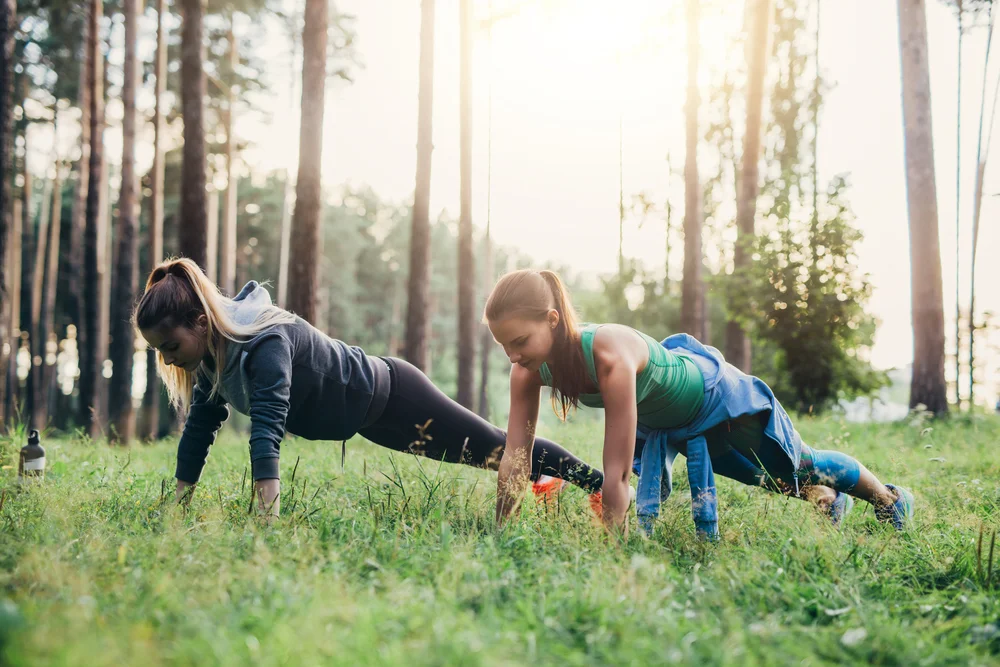
Are you a frequent traveler who wants to stay fit and healthy on the go? With ConnectPls, a mobile router, physical SIM or eSIM subscription service for travelers, you can access the internet and stay connected while you work out with bodyweight exercises. No need to worry about gym memberships or equipment. You can do these exercises anywhere, anytime, and at your own pace.
Bodyweight exercises are a great way to stay in shape while you travel. They can help you improve your strength, endurance, flexibility, and coordination. They can also help you prevent injuries and reduce stress. Plus, they are free and require little space and time.
In this article, we will explain what bodyweight exercises are, why they are beneficial, and how to do them properly. We will also give you some examples of bodyweight exercises for different muscle groups and fitness levels. By the end of this article, you will have a better understanding of how to use your own body weight as a tool for fitness and wellness with the help of ConnectPls.
What Are Bodyweight Exercises?
Bodyweight exercises are exercises that use your own body weight as resistance. You don’t need any weights, machines, or other equipment to perform them. All you need is your own body and some space.
Bodyweight exercises can be classified into two main types: static and dynamic. Static exercises involve holding a certain position for a period of time, such as a plank or a wall sit. Dynamic exercises involve moving your body through a range of motion, such as a squat or a push-up.
Static exercises are good for improving your posture, stability, and core strength. Dynamic exercises are good for improving your mobility, coordination, and power. Both types of exercises can also improve your cardiovascular health, as they can increase your heart rate and blood flow.
Why Are Bodyweight Exercises Beneficial?
Bodyweight exercises have many benefits for your physical and mental health, especially when combined with ConnectPls. Here are some of the main ones:
They are convenient.
You are able to do them anywhere, anytime, and with minimal preparation. You don’t have to worry about finding a gym, buying equipment, or setting up anything. Just use your own body and the environment around you. Plus, with ConnectPls, you can access the internet and stream workout videos or music to enhance your workout experience.
They Are Versatile.
You can modify them to suit your needs and preferences. Adjust the intensity, duration, frequency, and complexity of the exercises according to your fitness level and goals. You can also mix and match different exercises to create your own routines and challenges. Plus, with ConnectPls, you can download workout apps or trackers to monitor your progress and motivate you to keep going.
They Are Effective
They can work multiple muscles at once, rather than isolating one muscle or muscle group. This can help you burn more calories, build more muscle mass, and improve your functional fitness. They can also help you prevent injuries by strengthening your joints and ligaments. Plus, with ConnectPls, you can access fitness websites or blogs to learn more about the science behind the exercises and get expert advice.
They Are Fun
They can add variety and creativity to your workouts. You can try new movements, explore different locations, and challenge yourself in different ways. You can also do them with others, such as friends, family, or online communities. Plus, with ConnectPls, you can connect with other travelers or locals who share your interests and discover new places to exercise.
How to Do Bodyweight Exercises Properly?
To get the most out of bodyweight exercises, you need to do them properly. Here are some general tips on how to do bodyweight exercises safely and effectively:
- Warm up before you start. A warm-up is essential to prepare your body and mind for the exercise. It can help you increase your blood circulation, raise your body temperature, loosen your muscles and joints, and prevent injuries. A warm-up can consist of some light cardio activities, such as walking, jogging, skipping, or jumping jacks, followed by some dynamic stretches, such as arm circles, leg swings, or torso twists.
- Focus on your form. Form is the way you perform an exercise. It is important to maintain good form throughout the exercise to avoid injury and maximize results. Good form means keeping your body aligned, stable, and controlled. It also means breathing properly (inhaling during the easy part of the movement and exhaling during the hard part) and engaging your core muscles (the muscles around your abdomen and back) to support your spine.
- Choose the right level of difficulty. Difficulty is the level of challenge or intensity of an exercise. It is determined by factors such as the number of repetitions (reps), sets (groups of reps), rest periods (time between sets), range of motion (how far you move), speed (how fast you move), and leverage (how much weight you put on a certain body part). To choose the right level of difficulty for you, you need to consider your current fitness level and goals. You want to challenge yourself enough to make progress but not too much to cause pain or injury.
- Progress gradually. Progression is the process of increasing the difficulty of an exercise over time to keep improving your fitness level. Progression can be achieved by changing one or more factors of difficulty mentioned above. For example, you can increase the number of reps or sets, decrease the rest periods, increase the range of motion or speed, or decrease the leverage (for example by elevating your feet during a push-up). However, you should not progress too quickly or too often; otherwise, you may risk overtraining or injury.
- Rest and recover adequately. Rest is the time between workouts when your body repairs itself and adapts to the exercise stimulus. Recovery is the process of restoring your energy and function after a workout. Both rest and recovery are essential for your health and performance. They can help you prevent fatigue, soreness, inflammation, and injury. They can also help you improve your mood, motivation, and mental clarity. To rest and recover properly, you need to give yourself enough time between workouts (at least 24 hours for the same muscle group), get enough sleep (7 to 9 hours per night), eat well (balanced meals with enough protein, carbs, fats, vitamins, and minerals), hydrate well (drink water before, during, and after exercise), and manage stress (relax, meditate, or do something you enjoy). With ConnectPls, you can also use the internet to find healthy recipes, hydration tips, and stress management techniques.
Examples of Bodyweight Exercises for Different Muscle Groups and Fitness Levels
Now that you know what bodyweight exercises are, why they are beneficial, and how to do them properly with the help of ConnectPls, let’s look at some examples of bodyweight exercises for different muscle groups and fitness levels. We will divide the exercises into four categories: lower body, upper body (push), upper body (pull), and core. For each category, we will give you three examples of exercises: one for beginners, one for intermediate, and one for advanced. Of course, these are not the only bodyweight exercises available; there are many more that you can try and experiment with.
Lower Body Exercises
Lower body exercises work your legs, glutes, hips, and lower back. They can help you improve your balance, stability, posture, and power. They can also help you prevent lower back pain and knee problems.
- Beginner: Bodyweight Squat. A bodyweight squat is a basic lower body exercise that works your quads, hamstrings, glutes, and calves. To do a bodyweight squat:
- Stand with your feet shoulder-width apart and your toes slightly turned out.
- Keep your chest up, your shoulders back, and your core engaged.
- Bend your knees and push your hips back as if you were sitting on a chair.
- Lower yourself until your thighs are parallel to the floor or as low as you can comfortably go.
- Press through your heels and squeeze your glutes to stand up.
- Intermediate: Lunge. A lunge is a lower body exercise that works your quads, hamstrings, glutes, hip flexors, and calves. It also challenges your balance and coordination. To do a lunge:
- Stand with your feet hip-width apart and your hands on your hips or by your sides.
- Take a big step forward with one leg and bend both knees to lower yourself until both legs form 90-degree angles.
- Keep your front knee over your ankle and your back knee off the floor.
- Push through your front heel and bring your back leg forward to return to the starting position.
- Repeat with the other leg.
- Advanced: Pistol Squat. A pistol squat is a lower body exercise that works your quads, hamstrings, glutes, calves, hip flexors, and core. It is a single-leg squat that requires a lot of strength, balance, mobility, and flexibility. To do a pistol squat:
- Stand on one leg with the other leg extended in front of you.
- Keep your chest up, your shoulders back, and your core engaged.
- Bend your standing leg and push your hips back as if you were doing a regular squat.
- Lower yourself until your standing thigh is parallel to the floor or as low as you can comfortably go.
- Keep your extended leg straight and off the floor throughout the
Conclusion
Bodyweight exercises are no equipment workouts that you can do anywhere, anytime. They can help you improve your fitness, health, and well-being in many ways. They are convenient, versatile, effective, and fun. All you need is your own body weight and some space.
To get started with bodyweight exercises, you can try some of the examples we gave you for different muscle groups and fitness levels. You can also create your own routines by combining different exercises and changing the difficulty factors. Remember to warm up before you start, focus on your form, choose the right level of difficulty, progress gradually, and rest and recover adequately.
To learn more about ConnectPls’ eSIM subscription service for travelers and how it can help you stay connected while you work out with bodyweight exercises, visit our eSIM page.
We hope this article has inspired you to try bodyweight exercises and enjoy their benefits. Thank you for reading and happy exercising! 😊



